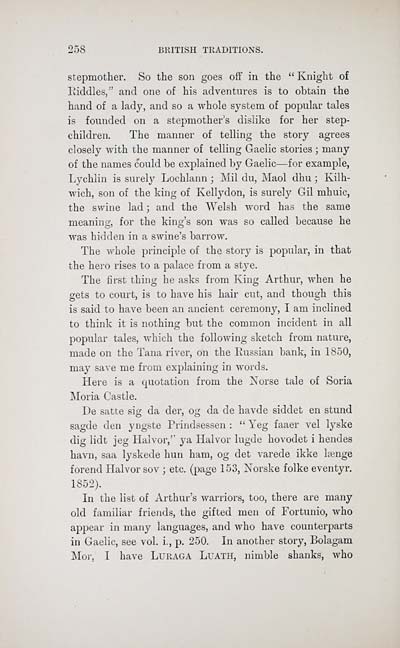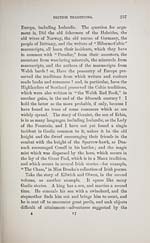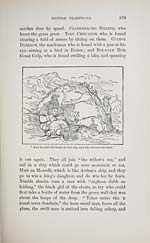Download files
Complete book:
Individual page:
Thumbnail gallery: Grid view | List view

258 BRITISH TRADITIONS.
stepmother. So the son goes off in the " Knight of
Riddles," and one of his adventures is to obtain the
hand of a lady, and so a whole system of popular tales
is founded on a stepmother's dislike for her step-
children. The manner of telling the story agrees
closely with the manner of telling Gaelic stories ; many
of the names could be explained by Gaelic — for example,
Lychlin is surely Lochlann ; Mil du, Maol dhu ; Kilh-
wich, son of the king of Kellydon, is surely Gil mhuic,
the swine lad ; and the Welsh word has the same
meaning, for the king's son was so called because he
was hidden in a swine's barrow.
The whole principle of the story is popular, in that
the hero rises to a palace from a stye.
The first thing he asks from King Arthur, when he
gets to court, is to have his hair cut, and though this
is said to have been an ancient ceremony, I am inclined
to think it is nothing but the common incident in all
popular tales, which the following sketch from nature,
made on the Tana river, on the Russian bank, in 1850,
may save me from explaining in words.
Here is a quotation from the Norse tale of Soria
Moria Castle.
De satte sig da der, og da de havde siddet en stund
sagde den yngste Prindsessen : " Yeg faaer vel lyske
dig lidt jeg Halvor,'' ya Halvor lugde hovodet i hendes
havn, saa lyskede hun ham, og det varede ikke laenge
forend Halvor sov ; etc. (page 153, Norske folke eventyr.
1852).
In the list of Arthur's warriors, too, there are many
old familiar friends, the gifted men of Fortunio, who
appear in many languages, and who have counterparts
in Gaelic, see vol. i., p. 250. In another story, Bolagam
Mor, I have LURAGA Luath, nimble shanks, who
stepmother. So the son goes off in the " Knight of
Riddles," and one of his adventures is to obtain the
hand of a lady, and so a whole system of popular tales
is founded on a stepmother's dislike for her step-
children. The manner of telling the story agrees
closely with the manner of telling Gaelic stories ; many
of the names could be explained by Gaelic — for example,
Lychlin is surely Lochlann ; Mil du, Maol dhu ; Kilh-
wich, son of the king of Kellydon, is surely Gil mhuic,
the swine lad ; and the Welsh word has the same
meaning, for the king's son was so called because he
was hidden in a swine's barrow.
The whole principle of the story is popular, in that
the hero rises to a palace from a stye.
The first thing he asks from King Arthur, when he
gets to court, is to have his hair cut, and though this
is said to have been an ancient ceremony, I am inclined
to think it is nothing but the common incident in all
popular tales, which the following sketch from nature,
made on the Tana river, on the Russian bank, in 1850,
may save me from explaining in words.
Here is a quotation from the Norse tale of Soria
Moria Castle.
De satte sig da der, og da de havde siddet en stund
sagde den yngste Prindsessen : " Yeg faaer vel lyske
dig lidt jeg Halvor,'' ya Halvor lugde hovodet i hendes
havn, saa lyskede hun ham, og det varede ikke laenge
forend Halvor sov ; etc. (page 153, Norske folke eventyr.
1852).
In the list of Arthur's warriors, too, there are many
old familiar friends, the gifted men of Fortunio, who
appear in many languages, and who have counterparts
in Gaelic, see vol. i., p. 250. In another story, Bolagam
Mor, I have LURAGA Luath, nimble shanks, who
Set display mode to: Large image | Transcription
Images and transcriptions on this page, including medium image downloads, may be used under the Creative Commons Attribution 4.0 International Licence unless otherwise stated. ![]()
| Early Gaelic Book Collections > Matheson Collection > Popular tales of the west Highlands > Volume 4 > (274) |
|---|
| Permanent URL | https://digital.nls.uk/81490345 |
|---|
| Description | Volume IV. |
|---|---|
| Shelfmark | Mat.77 |
| Additional NLS resources: | |
| Attribution and copyright: |
|
| Description | Items from a collection of 170 volumes relating to Gaelic matters. Mainly philological works in the Celtic and some non-Celtic languages. Some books extensively annotated by Angus Matheson, the first Professor of Celtic at Glasgow University. |
|---|
| Description | Selected items from five 'Special and Named Printed Collections'. Includes books in Gaelic and other Celtic languages, works about the Gaels, their languages, literature, culture and history. |
|---|

